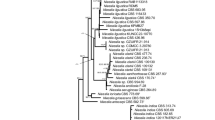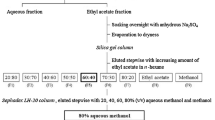Abstract
An organ-specific-growth inhibitory substance was isolated from an aqueous methanol extract of red pine needles and determined by spectral data as 1-mono(16-hydroxyhexadecanoyl)glycerol. This substance inhibited root growth of cress (Lepidium sativum L.) and barnyard grass (Echinochloa crus-galli (L.) Beauv) seedlings at concentrations greater than 0.01 and 0.03 μM, respectively. The concentrations required for 50 % growth inhibition on roots of cress and barnyard grass were 0.16 and 3.4 μM, respectively. However, the inhibitory activity of the substance on shoots of cress and barnyard grass was very weak. The endogenous concentration of 1-mono(16-hydroxyhexadecanoyl)glycerol in the pine needles was 4.6 μmol kg−1. Two related compounds, 1-monohexadecanoylglycerol and 16-hydroxyhexadecanlic acid had no activity up to 1,000 μM on cress roots and shoots. The effectiveness of 1-mono(16-hydroxyhexadecanoyl)glycerol on root growth inhibition and the occurrence of 1-mono(16-hydroxyhexadecanoyl)glycerol in pine needles suggest the substance may play an important role in the allelopathy of red pine. Root-specific-growth-inhibition by the substance may be one of the strategies for red pine to compete with neighboring plants for nutrients and space because root growth of competitive plants may be very important for their whole plant development.





Similar content being viewed by others
References
Bais HP, Weir TL, Perry LG, Gilroy S, Vivanco JM (2006) The role of root exudates in rhizosphere interactions with plants and other organisms. Annu Rev Plant Biol 57:233–266
Belz RG (2007) Allelopathy in crop/weed interactions—an update. Pest Manag Sci 63:308–326
Caboun V (2006) Tree-tree allelopathic interactions in middle European forests. Allelopathy J 17:17–31
Chu-Chou M (1978) Effects of root residues on growth of Pinus radiata seedlings and a mycorrhizal fungus. Ann Appl Biol 90:407–416
Dayan FE, Duke SO (2009) Biological activity of allelochemicals. In: Osbourn AE, Lanzotti V (eds) Plant-derived natural products: synthesis, function, and application. Springer, New York, pp 361–384
Duke SO, Dayan FE, Romagni JG, Rimando AM (2000) Natural products as sources of herbicide, current status and future trends. Weed Res 40:99–111
Einhellig FA (1999) An integrated view of allelochemicals amid multiple stresses. In: Inderjit, Dakshini KMM, Foy CL (eds) Principals and practices in plant ecology: allelochemical interactions. CRC Press, Boca Raton, pp 479–494
Fernandez C, Lelong B, Vila B, Mévy JP, Robles C, Greff S, Dupouyet S, Bousquet-Mélou A (2006) Potential allelopathic effect of Pinus halepensis in the secondary succession: an experimental approach. Chemoecology 16:97–105
Fernandez C, Voiriota S, Mévya JP, Vilaa B, Ormeñoa B, Dupouyeta S, Bousquet-Méloua A (2008) Regeneration failure of Pinus halepensis Mill.: the role of autotoxicity and some abiotic environmental parameters. For Ecol Manag 255:2928–2936
Graça J, Schreiber L, Rodrigues J, Pereira H (2002) Glycerol and glyceryl esters of ω-hydroxyacids in cutins. Phytochemistry 61:205–215
Harris MR, Lamb D, Erskine PD (2003) An investigation into the possible inhibitory effects of white cypress pine (Callitris glaucophylla) litter on the germination and growth of associated ground cover species. Aust J Bot 51:93–102
Inderjit (1996) Plant phenolics in allelopathy. Bot Rev 62:186–202
Jia L, Zhai M, Feng C (2003) Effects of allelopathic substances on the growth and photosynthesis of Pinus tabulaeformis seedlings. J Beijing For Univ 25:6–10
Kato-Noguchi H, Fushimi Y, Shigemori H (2009) An allelopathic substance in red pine needles (Pinus densiflora). J Plant Physiol 166:442–446
Kato-Noguchi H, Fushimi Y, Tanaka Y, Teruya T, Suenaga K (2011) Allelopathy of red pine: isolation and identification of an allelopathic substance in red pine needles. Plant Growth Regul 65:299–304
Kil BS, Yim YJ (1983) Allelopathic effects of Pinus densiflora on undergrowth of red pine forest. J Chem Ecol 9:1135–1151
Kim KW, Kim KU (2000) Searching for rice allelochemicals. In: Kim KU, Shin DH (eds) Rice allelopathy. Kyungpook National University, Korea, pp 83–95
Lee IK, Monsi M (1963) Ecological studies on Pinus densiflora forest 1. Effects of plant substances on the floristic composition of the undergrowth. Bot Mag 76:400–413
Lodhi MAK, Killingbeck KT (1982) Effects of pine-produced chemicals on selected understory species in a Pinus ponderosa community. J Chem Ecol 8:275–283
Nektarios PA, Economou G, Avgoulas C (2005) Allelopathic effects of Pinus halepensis needles on turfgrasses and biosensor plants. HortSci 40:246–250
Node M, Tomita-Yokotani K, Suzuki T, Kosemura S, Hirata H, Hirata K, Nawamaki T, Yamamura S, Hasegawa K (2003) Allelopathy of pinecone in Japanese red pine tree (Pinus densiflora Sieb. et Zucc.). Weed Biol Man 3:111–116
Putnam AR (1988) Allelochemicals from plants as herbicides. Weed Technol 2:510–518
Rice EL (1984) Allelopathy, 2nd edn. Academic Press, Orlando
Rimando AM, Duke SO (2003) Studies on rice allelochemicals. In: Smith CW, Dilday RH (eds) Rice; origin, history, technology and production. Wiley, New York, pp 221–244
Romagni JG, Allen SN, Dayan FE (2000) Allelopathic effects of volatile cineoles on two weedy plant species. J Chem Ecol 26:303–313
Seigler DS (1996) Chemistry and mechanisms of allelopathic interactions. Agron J 88:876–885
Son DS, Eon TJ, Seo JD, Lee SR (1996) A study on resistant substance to pine needle gall midge among phenolic compounds in pine needles. J Korean Forry Soc 85:372–380
Author information
Authors and Affiliations
Corresponding author
Rights and permissions
About this article
Cite this article
Kato-Noguchi, H., Fushimi, Y., Kimura, F. et al. Organ-specific-active allelopathic substance in red pine needles. Plant Growth Regul 68, 171–175 (2012). https://doi.org/10.1007/s10725-012-9703-5
Received:
Accepted:
Published:
Issue Date:
DOI: https://doi.org/10.1007/s10725-012-9703-5




